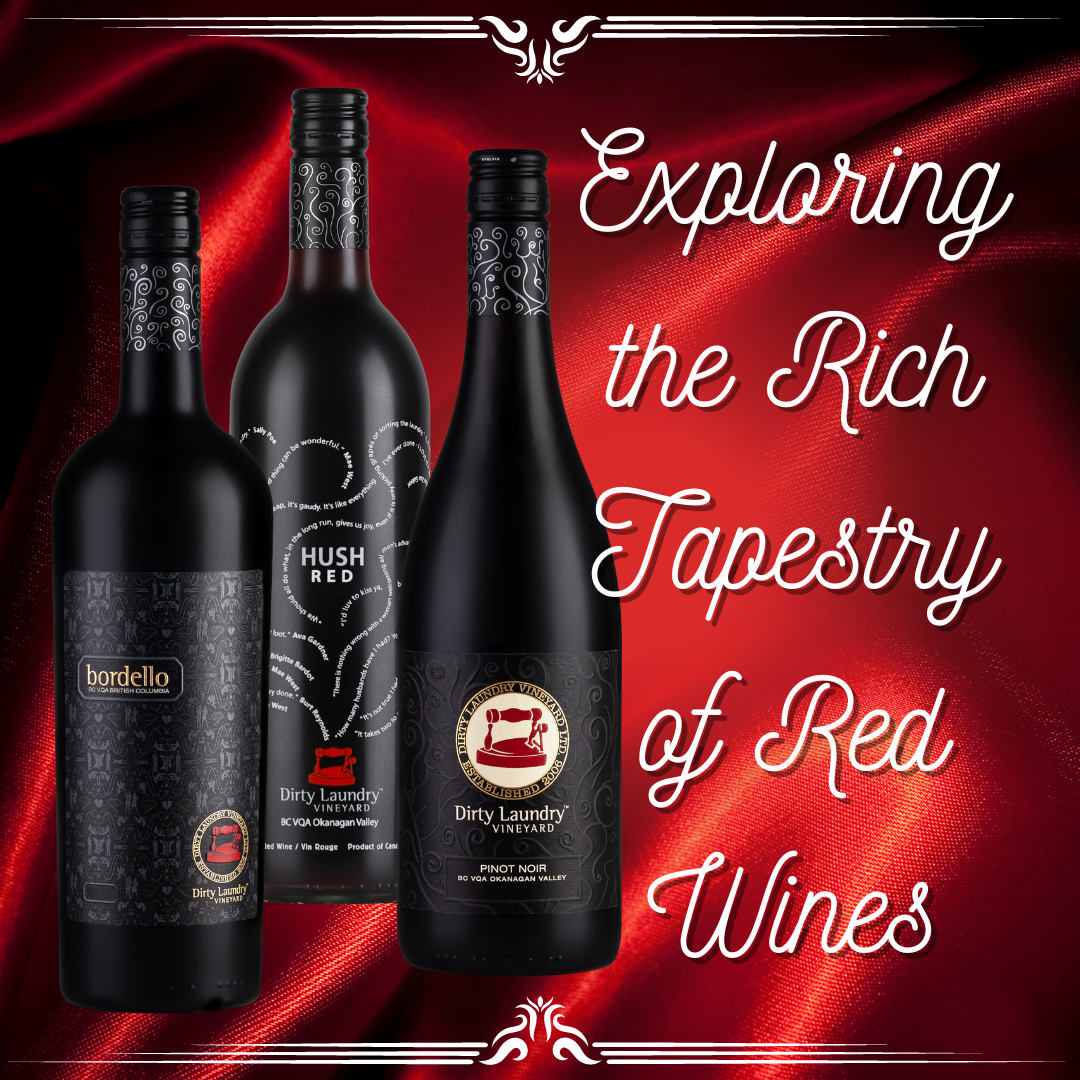Red wine, with its centuries-old history and intricate flavours, embodies the essence of sophistication and cultural heritage. Due in part to the sun-drenched hillsides of Oliver and Osoyoos, and the area’s combination of climate, soil, terroir, and suitable grape varietals, the Okanagan Valley in British Columbia has gained recognition for producing good Canadian red wines. Before we dive into what makes the red wines of the Okanagan so special and sought after by wine enthusiasts globally, let’s explore the uniqueness of red wines as a whole.
A Brief History of Red Wine
The story of red wine dates back thousands of years, tracing its roots to ancient civilizations such as the Greeks, Romans, and Egyptians. These early cultures revered wine not only for its intoxicating effects but also for its medicinal and religious significance. Over time, winemaking techniques evolved, leading to the development of distinct styles and grape varieties across different regions of the world.
Varieties of Red Wine
Red Wine Tasting Notes and Profiles
Red wines offer a kaleidoscope of flavours and aromas, influenced by factors like grape variety, climate, soil, and winemaking techniques. When tasting red wine, consider the following elements:
- Appearance: Note the wine's colour intensity and clarity, which can range from pale ruby to deep garnet.
- Aroma: Inhale deeply to discern the wine's bouquet, identifying aromas of fruits, spices, flowers, and earthy nuances.
- Palate: Explore the wine's flavour profile, paying attention to its balance of fruitiness, acidity, tannins, and alcohol. Notice the wine's texture, from silky and smooth to robust and grippy.
- Finish: Evaluate the length and complexity of the wine's finish, lingering with notes of fruit, oak, and minerality.
Check out
this article if you want to learn the five Ss of wine tasting to make you look like a professional.
Red Wine Bodies
The body of a wine refers to its perceived weight and richness, influenced by factors such as grape variety, alcohol content, and sweetness level.
- Light-bodied red wines: These wines are typically lower in alcohol content and tannins, with lighter flavours and a smoother mouthfeel. Pinot Noir, for example, is a light-bodied red wine.
- Full-bodied red wines: These wines have higher alcohol content and tannins, with bold flavours and a more intense mouthfeel. Full-bodied red wines include Cabernet Sauvignon and Syrah.
Storing Red Wine
Many wine enthusiasts enjoy visiting wineries, tasting various wines, and collecting bottles of their favourites, often opting to store them for future enjoyment rather than drinking them right away. Storing red wine properly is essential to fully enjoy its flavours and aromas. When storing red wine, it's important to keep it in a cool, dark place with consistent temperature and humidity levels to prevent oxidation and spoilage. Ideally, red wine should be stored horizontally to keep the cork moist and intact, preventing it from drying out and allowing air to seep in, which can ruin the wine.
Serving Red Wine
Food Pairings
Enjoying red wine with the right food pairings can enhance the overall tasting experience, so consider matching the wine's characteristics with complementary dishes to fully appreciate its nuances. Consider these classic pairings:
- Cabernet Sauvignon: Pair with hearty dishes like steak, lamb, or aged cheeses, as the wine's tannins complement rich, flavourful meats.
- Pinot Noir: Pair with roasted poultry, salmon, or mushroom-based dishes, as the wine's acidity and delicate flavours enhance lighter fare.
- Merlot: Pair with pasta dishes, roasted vegetables, or soft cheeses, as the wine's velvety texture and ripe fruit flavours provide a versatile match.
- Syrah/Shiraz: Pair with barbecued meats, game, or spicy dishes, as the wine's bold flavours and peppery notes stand up to robust flavours.
- Zinfandel: Pair with grilled meats, tomato-based dishes, or aged cheeses, as the wine's ripe fruitiness and spicy character complement bold flavours.
What Makes the Red Wines of the Okanagan Valley Unique?
Wine experts often praise BC red wines — and those produced in the Okanagan in particular — for their quality, diversity, and potential for excellence, recognizing the Okanagan Valley as a rising star in the global wine industry. There are many acclaimed wineries in the region that have received recognition both domestically and internationally for their high-quality red wines. These awards often cover a wide range of categories, including best varietal wines, best blends, sustainability practices, and overall excellence in winemaking.
These are a just a few of the reasons that the Okanagan Valley is able to produce award-winning Canadian red wines that continue to garner international acclaim and recognition:
Climate:
The Okanagan Valley has a unique microclimate ideal for grape cultivation, particularly for red wine varietals. Its semi-arid climate with hot summers and mild winters provides optimal conditions for ripening grapes, resulting in intense flavours and balanced acidity in the wines.
Terroir: The valley's diverse terroir, characterised by a variety of soil types, slopes, and elevations, allows for the cultivation of a wide range of grape varietals. Different terroirs contribute distinct characteristics to BCs red wines, adding complexity and depth.
Varietals: The Okanagan Valley is known for producing a variety of red wine grapes, including
Merlot,
Cabernet Sauvignon,
Pinot Noir, and
Syrah. Winemakers often blend these varietals or produce single-varietal wines to showcase the region's unique terroir and grape quality. At Dirty Laundry, some of our unique blends include:
- Dangerous Liaison - A blend of merlot and malbec sourced from very hot sites in Osoyoos produce a bright and bold BC red wine with a very fruity finish.
- Hush Red - A blend of small lot fermentations of merlot, malbec and cabernet sauvignon makes this medium weight BC red wine easy drinking, bright and a real crowd pleaser.
- Bordello - This Bordeaux-style Canadian red wine is a blend of petit verdot, cabernet sauvignon and merlot, resulting in a smooth, velvety representation of the best the Okanagan can deliver in terms of high quality red wine.
Innovation and Expertise: Over the years, the Okanagan wine industry has seen significant growth and investment, leading to advancements in viticulture and winemaking techniques. Winemakers in the region continually experiment with new methods and technologies to produce high-quality wines that reflect the character of the Okanagan Valley.
Sustainability: Many wineries in the Okanagan Valley are committed to sustainable and environmentally friendly practices, including organic and biodynamic farming methods. This focus on sustainability not only preserves the natural beauty of the region but also contributes to the overall quality and purity of the wines.
Whether enjoyed on its own or paired with a sumptuous meal, BCs best red wines invite us to savour life's simple pleasures and celebrate the beauty of shared moments. And where better than the stunning landscapes of the Okanagan Valley, with its picturesque vineyards nestled between lakes and mountains that attract visitors from around the world to discover new and exciting BC red wine varietals. So raise your glass, toast to tradition, and embark on a journey of discovery through the world of Canadian red wines.
Cheers!




